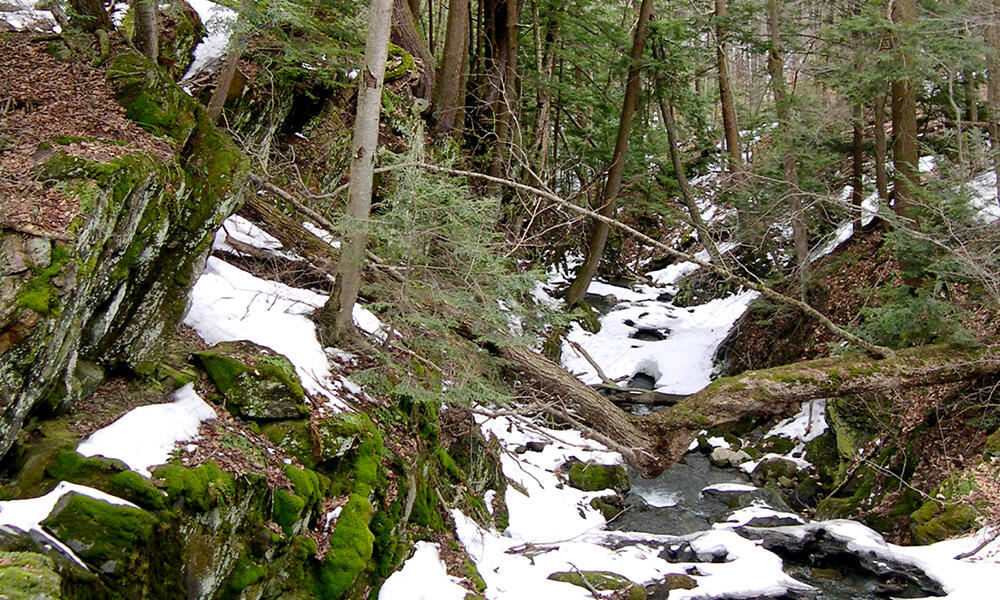Habitat description
Steep cold streams are small, fast-flowing waterways, with a stream order between 1-4, slopes greater than 2%, steep valley walls, and summer water temperatures below 20°C. These streams heavily rely on shade from riparian buffer habitat or a strong groundwater connection to stay cold throughout the year. Their rocky beds, made up of bedrock, cobble, gravel, and boulders, provide homes for aquatic invertebrates in its riffles and pools, especially during drought conditions. In Massachusetts, coldwater rivers and streams are identified as those where at least 1 of 11 coldwater fish species are found.
Characteristic communities and species
Brook trout and slimy sculpin dominate these streams. As watershed size increases, other species of fish such as longnose dace, blacknose dace, and creek chub are more common. Dragonfly species include ocellated darner, Maine riffle, brook snaketails, southern and northern pygmy clubtails, and twin-spotted spiketail. Mussels are typically absent due to the lack of fine substrate like sand. Birds and mammals associated with this habitat include: belted kingfisher, great blue heron, hooded merganser, wood duck, Louisiana waterthrush, mink, racoon, short and long-tailed weasel, and beaver.
View a complete list of Species of Greatest Conservation Need associated with this habitat.
Associated habitats
Ecological processes
Shaped by high-energy water flows and steep gradients, these streams keep substrates like cobble and gravel moving, providing essential habitats for aquatic species. Beavers build dams and lodges that seasonal floods wash away, adding large woody material to the system. Riparian habitats provide the major source of energy and nutrients through fallen leaves and terrestrial invertebrate inputs, while also stabilizing banks to prevent erosion. Invertebrates, including sensitive species, break down larger leaves and woody material into smaller particles used by other organisms downstream. Streams in north-facing hemlock forests maintain very cold habitats in the summer and provide relatively little energy inputs to invertebrates, whereas streams flowing through landscapes dominated by oak or maple are warmer and more productive. This dynamic increases productivity and promotes diverse channel structures.
Threats
- Climate change is increasing the frequency and severity of extreme weather events such as floods and droughts, shifting precipitation patterns, and raising summer temperatures. These changes threaten the stability of habitats, reduce water availability, and stress both aquatic species and human infrastructure.
- Land use changes, including urbanization, significantly impacts these systems, as steep valley walls are prone to erosion when disturbed. Vegetation is essential for stabilizing soil and preventing substrate loss. Deforestation and floodplain encroachment can lead to catastrophic erosion, particularly when exposed soils face high stream discharge. Floodplain development, channelization, and improperly sized culverts disrupts natural stream processes by increasing erosion and sedimentation and can lead to reduction in water quality and habitat connectivity. Channel alteration, including channelization and watershed encroachment, reduces water levels and groundwater inputs, making these systems more vulnerable to temperature increases and limits coldwater refugia.
- Water withdrawal, mostly through groundwater extraction through wells or interception by reservoirs, reduces the amount of water available to the stream, especially in critical summer months when flows are naturally low. Water withdrawal can be severe in small streams and results in a functional increase in the severity and duration of drought conditions. Reservoirs located in the headwaters of streams provide water quality protection for water supply but can also trap a significant portion of annual rainfall, impacting stream flows.
- Invasive species, including those affecting streambanks, can outcompete native species and alter community structures.
Restoration & management recommendations
In steep cold streams, priority is given to protecting the watershed to avoid erosion, removing dams, and replacing culverts with more climate resilient infrastructure.
- Dam removal: Dams are ubiquitous across Massachusetts and have historically been used to generate power, store water, and manage flows. Dam removal provides multiple benefits, including improved fish passage, enhanced connectivity of climate refugia, and reduced liability for landowners. Depending on the site, sediment removal or natural sediment release can restore downstream habitats. In cases where full removal is not feasible, partial removal or bypass structures can help restore some natural functions, including sediment transport and fish migration. Steep streams were often targeted for dam construction due to their capacity to generate vertical head. Removal of dams in these systems can mitigate severe erosion risks, improve habitat connectivity, and restore natural channel-forming processes. In areas with bedrock, partial removal may achieve significant ecological benefits, but in areas prone to erosion, full removal is recommended to prevent downstream degradation.
- Culvert replacement: In steep streams, culverts are often installed at improper elevations, becoming perched over time and impeding fish passage. Proper culvert replacement in these systems reduces erosion risks and allows the high-energy flow to maintain substrate dynamics while preserving habitat connectivity.
- Channel and shoreline restoration: In high-gradient systems, restoration aims to reestablish natural channel processes and sediment transport. Historical channelization and armoring have disrupted these dynamics, leading to increased downstream erosion. Efforts should focus on removing hard structures, creating side channels, and establishing benches to stabilize banks and enhance habitat complexity.
- Floodplain restoration: Floodplain restoration enhances ecological functions by reconnecting streams and rivers to their natural floodplains. These actions improve water storage, groundwater infiltration, and climate resilience while supporting biodiversity and water quality. In steep terrains, floodplain restoration focuses on mitigating erosion and stabilizing slopes. Effective strategies include revegetation, stormwater management, and removing impervious surfaces to reduce sediment transport. Maintaining shaded canopies further protects these systems from temperature increases.
- Water quality: Protecting and restoring water quality is critical across all habitats. Effective strategies include maintaining riparian buffers and shaded canopies to reduce sedimentation and mitigate warming, addressing sources of pollution such as urban runoff and wastewater effluent, minimizing nutrient overloading to prevent algal blooms, and implementing site-specific actions like reengineering stormwater systems and improving wastewater treatment to address localized threats.
